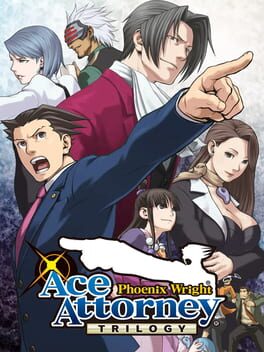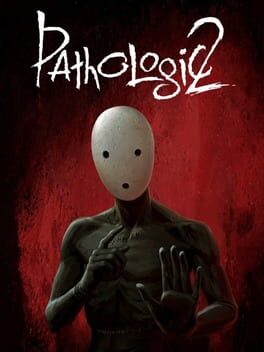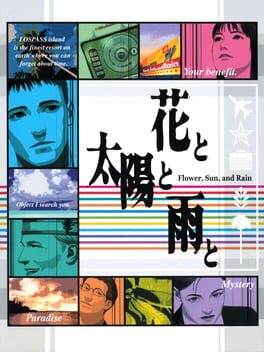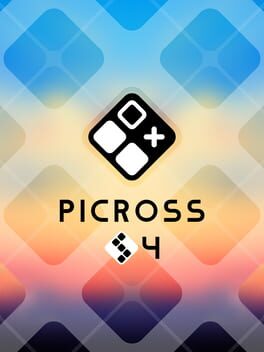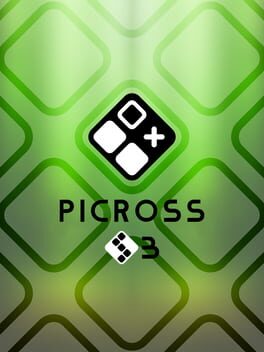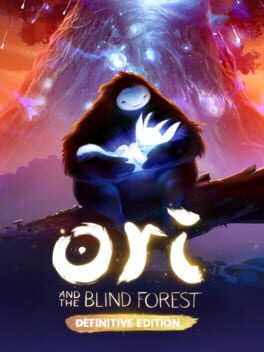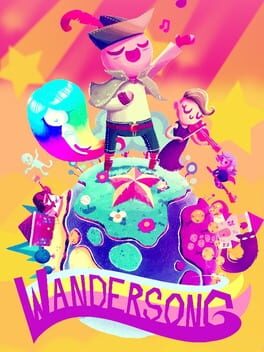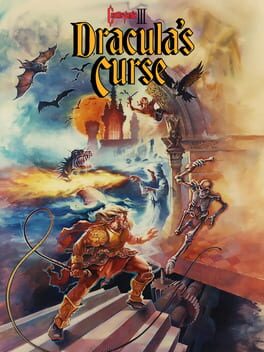kesshikou
Bio
Nothing here!
Badges

3 Years of Service
Being part of the Backloggd community for 3 years

Liked
Gained 10+ total review likes

Popular
Gained 15+ followers

N00b
Played 100+ games

Noticed
Gained 3+ followers
Favorite Games
200
Total Games Played
003
Played in 2024
008
Games Backloggd
Recently Played See More
Recently Reviewed See More
Ori and the Blind Forest has lovely visuals, a simple and heartwarming story, and some really inspired ideas for platformer exploration, but artificial difficulty and hiccups in the interactions between movement options and the environment can make it more of a chore to play through than it should be.
There are a few ingredients for a guaranteed indie smash these days: Metroidvania layout, difficult platforming sections, and a somber and largely wordless story. I don’t mean to be too cynical here, but it’s the combination of these elements that brought smash success, in particular, to Hollow Knight and Ori and the Blind Forest. Eventually, I’ll try to unpack what disappoints me with the former game, but having just finished a playthrough of the latter and having recently played a fantastic Castlevania game not too long ago (Circle of the Moon), I have some fresh thoughts on why these trendier indies have a hard time appealing to me.
Let’s start with the basics: there is some inherent tension in the different design elements at play here. Metroidvanias reward, at their best, expansive exploration. Getting lost in a world isn’t necessarily the point, as many of the best in the genre guide you along almost invisibly, but coming up to doors you can’t open or ledges you can’t reach and circling back later is part and parcel of the experience.
This can be strongly at odds with incorporating difficult platforming into the formula, as it becomes unclear at times when you’re failing to execute a complex task vs. when you’re just not supposed to go somewhere right at the moment. Ori falls into this trap most often in the opening sections of the game, where you have limited movement options. Sometimes, a wrong turn will land you in a bed of spikes, and you’re given very little time to react and reflect on what just happened before you’re respawned. It can be extremely confusing when you’re just missing where they want you to land from a long drop or when you’re being told to back off. Ori’s solution to this problem is inelegant: the map (along the main story path, which is mostly what I stuck to in my own playthrough) has very few turns to it, so you basically go and check off everywhere else and then heave a sigh and get ready to die a few times to map out where you’re supposed to go.
And you might as well get used to that feeling of hitting spikes and not understanding why, as the game will mercilessly throw them in your path as often as possible. Following the critical pathway down after a difficult section? You better fucking have resources on hand to pop a save because there’s no telling what’s down that pit. The camera moves somewhat cinematically to follow you, and it can have a hard time catching up with the floor before you do. Later on, are you trying to see what you can reach with a charged jump? You’re almost definitely going to smash your head on spikes. I became so conditioned to this that in the second dungeon, I spent about ten minutes trying to figure out a puzzle (a puzzle that’s basically supposed to introduce you to the gimmick of the dungeon) because the blades of grass sitting on a random platform looked too much like spikes to me to trust that I could land on it and use it as a sounding area for what I was supposed to do.
This gets even worse when you’re not solving a puzzle and in fact know what you’re supposed to do. Later on, you’ll have to boost jump off of wall surfaces, and this sometimes requires you to go at an upward diagonal angle. Because you know being off by a centimeter will smash you into spikes, you try some precision aiming and… Ori has slid himself up the wall and into some spikes that are just there for the fuck of it. Like the Metroidvania elements, the spikes that litter this game feel like window dressing, adding an artificial challenge where decent game design would have worked just as well. I get it, the forest is hostile, but there really has to be some other way to separate out narrow landing areas that resets your position with the platforming challenge that doesn’t kill you for being slightly off.
This is annoying in regular play, but the game’s obsession with cinematic platforming sections means you’ll be going up against this as the game expects you to basically learn flawless execution for some really difficult platforming sections. This kind of thing is fun in Rayman’s racing levels, partially because those are optional and partially because you’re well aware before you jump in what’s going to be in store. You also know that Ubisoft has honed those levels to mechanical perfection, so once you learn a piece, you’ve learned it forever. The weird physics of Ori are far from perfect, despite what you’ll bafflingly see on this page and other reviews. I did the second and third “escape the area” sections over and over, and I can tell you that exact, identical execution sometimes randomly landed Ori just a hair short of where he was supposed to be or ran him out of rhythm with the elements around him, resulting in damage or death. The very final gameplay section has an all new visual element that you have to compute perfectly the second you hit it or else repeat about two minutes of technical gameplay all at once. And, I can confirm, that element is not mechanically wound. There’s RNG involved in the spacing of the stuff, which means you can kill yourself through no fault of your own besides keeping pace.
It’s worth going into that element a bit more. I’m surprised I don’t see more complaints about the Bash mechanic. Jesus Christ, Bash. Okay, so when you first get Bash, it’s the coolest fucking thing ever. It feels really fresh to me. Maybe I’m missing what game they stole it from. You basically can grab a projectile or (some) enemies in a sort of stasis field and redirect their momentum around Ori. This has two uses. The first is movement, where you’ll utilize an enemy or their projectile to shoot yourself, say, upward, to reach heights you couldn’t normally. The second is for breaking stuff, where you’ll either redirect projectiles or enemies into vulnerable surfaces or other enemies to progress. It’s a really, really fun mechanic. On paper.
The trouble sets in when you reach some of the more technical situations later on. Some pathways require chaining of multiple enemies’ projectiles to reach where you need to go, and these enemies’ lock-on is really unpredictable. So you’ll be in the air with minimal room or time to adjust, and if a projectile shoots too low for you to catch it, say hello to your old friends the spikes. At least that can feel like your fault. Try enemies that just randomly stop deciding to shoot at you, leaving you to slowly fall to a lower level or (let’s be real here, it’s Ori’s favorite thing to do to you) your death on fucking spikes. These sections are miserable and take one of the best mechanics in the game and ruin them. I went from extremely excited to Bash everything in sight to feeling extreme relief when the mechanic was set aside.
And a lot of that relief came from the fact that when you’re not being put in scripted chases or set up for platforming failure for the fuck of it, moving Ori around feels really nice. The lack of precision allows you to focus instead on momentum, and chaining together movement techniques to just get around is really fun. It feels like blasphemy to compare these two, but it really does feel like the movement in a Mario game when it works. The issue is that Mario is in some of the best games ever and gets to utilize that movement in enjoyable levels, and Ori is usually stuck coming to a complete stop or an early demise before a flow state can be reached.
It feels almost like bullying to add this in, but the combat in this game is just wretched. There’s five enemies: jumpers, splitters, moving projectile spitters, stationary projectile spitters, dive bombers, and chargers. The same boss is used in all three dungeons with a palette swap and does not even vary tactics in each one. Please do yourself a favor and upgrade your attack, as without the upgrades, the combat will take even longer, and no one deserves to deal with this combat longer than absolutely necessary. Enemies are haphazardly placed to basically cut your momentum, forcing you to stand in one place and spam the attack button until they’re done wigging out and you can go back to playing the game. At worst, they will keep themselves on a ledge or narrow platform you have to land on and basically force you to tank damage to proceed. Not fun.
This obsession with artificial difficulty and sloppiness in level and combat design is a real shame, because there is a lot to love about Ori. The visuals are very pleasant, and I didn’t have an issue with saminess of environments, as I think they played around within the forest theme pretty wonderfully. The story is genuinely very touching for as simple as it is. And it’s fun to have a narrowly honed, somewhat linear game beneath the Metroidvania pretense. I wonder if there were just built-in checkpoints and the team got to just make a platformer if the strengths around movement and abilities could have been honed a bit better to less maddening effect.
Unfortunately, this was one of those games I left more relieved it was over than glad I had engaged it. I had plans to go on to Will of the Wisps, but I think I’m going to pass for now and revisit the series at some point if I get word that they’ve improved on my complaints, which seems unlikely given that everyone seems to have nothing but effusive praise for the games. Oh well.
There are a few ingredients for a guaranteed indie smash these days: Metroidvania layout, difficult platforming sections, and a somber and largely wordless story. I don’t mean to be too cynical here, but it’s the combination of these elements that brought smash success, in particular, to Hollow Knight and Ori and the Blind Forest. Eventually, I’ll try to unpack what disappoints me with the former game, but having just finished a playthrough of the latter and having recently played a fantastic Castlevania game not too long ago (Circle of the Moon), I have some fresh thoughts on why these trendier indies have a hard time appealing to me.
Let’s start with the basics: there is some inherent tension in the different design elements at play here. Metroidvanias reward, at their best, expansive exploration. Getting lost in a world isn’t necessarily the point, as many of the best in the genre guide you along almost invisibly, but coming up to doors you can’t open or ledges you can’t reach and circling back later is part and parcel of the experience.
This can be strongly at odds with incorporating difficult platforming into the formula, as it becomes unclear at times when you’re failing to execute a complex task vs. when you’re just not supposed to go somewhere right at the moment. Ori falls into this trap most often in the opening sections of the game, where you have limited movement options. Sometimes, a wrong turn will land you in a bed of spikes, and you’re given very little time to react and reflect on what just happened before you’re respawned. It can be extremely confusing when you’re just missing where they want you to land from a long drop or when you’re being told to back off. Ori’s solution to this problem is inelegant: the map (along the main story path, which is mostly what I stuck to in my own playthrough) has very few turns to it, so you basically go and check off everywhere else and then heave a sigh and get ready to die a few times to map out where you’re supposed to go.
And you might as well get used to that feeling of hitting spikes and not understanding why, as the game will mercilessly throw them in your path as often as possible. Following the critical pathway down after a difficult section? You better fucking have resources on hand to pop a save because there’s no telling what’s down that pit. The camera moves somewhat cinematically to follow you, and it can have a hard time catching up with the floor before you do. Later on, are you trying to see what you can reach with a charged jump? You’re almost definitely going to smash your head on spikes. I became so conditioned to this that in the second dungeon, I spent about ten minutes trying to figure out a puzzle (a puzzle that’s basically supposed to introduce you to the gimmick of the dungeon) because the blades of grass sitting on a random platform looked too much like spikes to me to trust that I could land on it and use it as a sounding area for what I was supposed to do.
This gets even worse when you’re not solving a puzzle and in fact know what you’re supposed to do. Later on, you’ll have to boost jump off of wall surfaces, and this sometimes requires you to go at an upward diagonal angle. Because you know being off by a centimeter will smash you into spikes, you try some precision aiming and… Ori has slid himself up the wall and into some spikes that are just there for the fuck of it. Like the Metroidvania elements, the spikes that litter this game feel like window dressing, adding an artificial challenge where decent game design would have worked just as well. I get it, the forest is hostile, but there really has to be some other way to separate out narrow landing areas that resets your position with the platforming challenge that doesn’t kill you for being slightly off.
This is annoying in regular play, but the game’s obsession with cinematic platforming sections means you’ll be going up against this as the game expects you to basically learn flawless execution for some really difficult platforming sections. This kind of thing is fun in Rayman’s racing levels, partially because those are optional and partially because you’re well aware before you jump in what’s going to be in store. You also know that Ubisoft has honed those levels to mechanical perfection, so once you learn a piece, you’ve learned it forever. The weird physics of Ori are far from perfect, despite what you’ll bafflingly see on this page and other reviews. I did the second and third “escape the area” sections over and over, and I can tell you that exact, identical execution sometimes randomly landed Ori just a hair short of where he was supposed to be or ran him out of rhythm with the elements around him, resulting in damage or death. The very final gameplay section has an all new visual element that you have to compute perfectly the second you hit it or else repeat about two minutes of technical gameplay all at once. And, I can confirm, that element is not mechanically wound. There’s RNG involved in the spacing of the stuff, which means you can kill yourself through no fault of your own besides keeping pace.
It’s worth going into that element a bit more. I’m surprised I don’t see more complaints about the Bash mechanic. Jesus Christ, Bash. Okay, so when you first get Bash, it’s the coolest fucking thing ever. It feels really fresh to me. Maybe I’m missing what game they stole it from. You basically can grab a projectile or (some) enemies in a sort of stasis field and redirect their momentum around Ori. This has two uses. The first is movement, where you’ll utilize an enemy or their projectile to shoot yourself, say, upward, to reach heights you couldn’t normally. The second is for breaking stuff, where you’ll either redirect projectiles or enemies into vulnerable surfaces or other enemies to progress. It’s a really, really fun mechanic. On paper.
The trouble sets in when you reach some of the more technical situations later on. Some pathways require chaining of multiple enemies’ projectiles to reach where you need to go, and these enemies’ lock-on is really unpredictable. So you’ll be in the air with minimal room or time to adjust, and if a projectile shoots too low for you to catch it, say hello to your old friends the spikes. At least that can feel like your fault. Try enemies that just randomly stop deciding to shoot at you, leaving you to slowly fall to a lower level or (let’s be real here, it’s Ori’s favorite thing to do to you) your death on fucking spikes. These sections are miserable and take one of the best mechanics in the game and ruin them. I went from extremely excited to Bash everything in sight to feeling extreme relief when the mechanic was set aside.
And a lot of that relief came from the fact that when you’re not being put in scripted chases or set up for platforming failure for the fuck of it, moving Ori around feels really nice. The lack of precision allows you to focus instead on momentum, and chaining together movement techniques to just get around is really fun. It feels like blasphemy to compare these two, but it really does feel like the movement in a Mario game when it works. The issue is that Mario is in some of the best games ever and gets to utilize that movement in enjoyable levels, and Ori is usually stuck coming to a complete stop or an early demise before a flow state can be reached.
It feels almost like bullying to add this in, but the combat in this game is just wretched. There’s five enemies: jumpers, splitters, moving projectile spitters, stationary projectile spitters, dive bombers, and chargers. The same boss is used in all three dungeons with a palette swap and does not even vary tactics in each one. Please do yourself a favor and upgrade your attack, as without the upgrades, the combat will take even longer, and no one deserves to deal with this combat longer than absolutely necessary. Enemies are haphazardly placed to basically cut your momentum, forcing you to stand in one place and spam the attack button until they’re done wigging out and you can go back to playing the game. At worst, they will keep themselves on a ledge or narrow platform you have to land on and basically force you to tank damage to proceed. Not fun.
This obsession with artificial difficulty and sloppiness in level and combat design is a real shame, because there is a lot to love about Ori. The visuals are very pleasant, and I didn’t have an issue with saminess of environments, as I think they played around within the forest theme pretty wonderfully. The story is genuinely very touching for as simple as it is. And it’s fun to have a narrowly honed, somewhat linear game beneath the Metroidvania pretense. I wonder if there were just built-in checkpoints and the team got to just make a platformer if the strengths around movement and abilities could have been honed a bit better to less maddening effect.
Unfortunately, this was one of those games I left more relieved it was over than glad I had engaged it. I had plans to go on to Will of the Wisps, but I think I’m going to pass for now and revisit the series at some point if I get word that they’ve improved on my complaints, which seems unlikely given that everyone seems to have nothing but effusive praise for the games. Oh well.
While Wandersong begins with pitch-perfect puzzles and story beats, its writing quickly becomes quite one-note, and the dragging coda will likely dissuade players from enjoying repeat performances.
Wandersong is the story of a young bard whose mission, in the face of a looming apocalypse, is to gather the pieces of the mythical Eversong, the united musical intonations of all the living, to repel disaster. The bard is joined by Miriam, a cynical but talented witch, and they visit a great many locales filled with unique denizens to seek out the keepers of the pieces of the Eversong, the Overseers.
Early on, it is established that the bard is not the hero of this tale—that would be The Hero, who wields a sword that shoots lightning and wishes to kill the Overseers to accelerate the end of the world and the creation of the next. The bard and Miriam pursue their mission peacefully, with the bard’s musical stylings the key to their success (reflecting the game itself, which with a couple notable exceptions, excels most in its choonz), whether it’s in convincing townspeople or animals to help them or by generating magical spells.
Thus, the game has a very simple subversion as the core of its gameplay and narrative. While the concept of the traditional video game hero as a raging murderous psychopath and the player’s insertion into an unbecoming, non-traditional hero isn’t new, the game uses it well enough for the opening hours. The bard and Miriam are likeable enough characters and play off each other well. You really get to share the bard’s stupid optimism and distrust of The Hero. And then it’s fun to suddenly find yourself playing as The Hero for a brief section, playing a serviceable action platformer.
As the bard, you will constantly be met with pastiche of different genres. While you’re basically always playing a puzzle platformer, some towns will have light life sim elements with day/night cycles or require small fetch quests or play more like a narrative-focused “walking sim” like Night in the Woods. The dungeons, if you can call them that, always have a new singing-controlled gimmick. Boss fights and Act-ending puzzles (used to actually learn the Earthsong) are varied enough to stay fresh, and when they work, they work well. The gameplay never gets particularly interesting, but the novelty is entertaining enough for a while.
What’s really going to make or break the game for you is if you enjoy its writing. While, like all things in Wandersong, it starts off delightful, a nagging sensation begins to form as you get deeper into the story. The problem for me is this: every single character speaks in exactly the same voice. For a game like Wandersong, where a large part of the appeal is in charming dialogue and character writing, it’s a huge issue when everyone sounds like a standard online millennial. Every single character has the same obnoxious, vaguely sarcastic way of interacting with one another. When it comes time for a character’s arc to develop, no matter what the character’s troubles or ostensible personality traits, they become unbelievably emotionally intelligent and open. I can certainly understand and appreciate that the bard is a wonderful, charming force for good in the world, but these kinds of characters typically need foils, and even the gruffest and rudest denizens of one of the half dozen or so locales the player visits talks in the same, y’know, um… voice. I certainly would never ask a game with the charm and optimistic aim of Wandersong to create emotionally ambiguous resolutions for its characters, but having the characters be characters instead of vehicles for snappy dialogue and repetitive themes about accepting themselves would be greatly appreciated. While the character designs are lovely, and I admire the ambition of creating a great ensemble cast the player would become invested in for the grand resolution, simplifying the game to include fewer characters might have helped to add to the variety of proceedings and allowed some time for characters and their arcs to breathe. By the end of the game, I found myself completely disinterested in hearing the same fucking tone of voice from another town full of people and trying to keep it down when it was force-fed to me during required story interactions contained to the main few characters.
The gameplay similarly sees the wheels fly off by the end of the game. The challenge never develops at all, and instead puzzles just cycle through new gimmicks. This is perfectly fine, but just as a mechanic seems to feel like it’s working and producing some interesting gameplay, the game cuts it off. So you’re constantly teased with fun scenarios with new abilities, just to have them ripped away for an exhausting stretch of dialogue before you move on to the next puzzle gimmick that will be completely under-utilized for a good 75% of the time you’re using it. The ending stretch doesn’t even feature fun gimmicks to begin with and often feel like tedious, simplistic slogs. It’s in these moments, where you’re sitting there doing something stupidly simple, that the little quirks start to feel extremely irritating.
My performance in the game is not really impacted by my ability to keep up with a piece of music or gameplay (the worst penalty is moving back about twenty seconds in a boss encounter at absolute worst), but I’d like to hear this song properly or react to this boss quickly (mostly so I can get one of Wandersong’s horrible boss battles over with faster). Why, oh why, does Wandersong’s metronome feature for pointing out which direction to mash your right analog stick not function like any other rhythm game ever? And why did they put dead zones between the eight input directions of the controller when your stick is resting at center? I’m not playing this on the GameCube. I’m not gonna be able to switch from one side to another (through dead center, always, for boss battles) with pinpoint accuracy if you make the dead zones show up when they’re most cumbersome!
Honestly, if Wandersong were a bit tighter, trimming off some of the more redundant areas to make a solid, say, four-act story with varied and interesting characters, these gripes about the mechanics and dialogue would probably be much more minor. But subjecting myself to seven hours of this felt like complete misery by the end. And for those of you who have finished the game, I’ll just let you imagine how red my face was as I played through that endless, tuneless epilogue cutscene… twice…
Wandersong is the story of a young bard whose mission, in the face of a looming apocalypse, is to gather the pieces of the mythical Eversong, the united musical intonations of all the living, to repel disaster. The bard is joined by Miriam, a cynical but talented witch, and they visit a great many locales filled with unique denizens to seek out the keepers of the pieces of the Eversong, the Overseers.
Early on, it is established that the bard is not the hero of this tale—that would be The Hero, who wields a sword that shoots lightning and wishes to kill the Overseers to accelerate the end of the world and the creation of the next. The bard and Miriam pursue their mission peacefully, with the bard’s musical stylings the key to their success (reflecting the game itself, which with a couple notable exceptions, excels most in its choonz), whether it’s in convincing townspeople or animals to help them or by generating magical spells.
Thus, the game has a very simple subversion as the core of its gameplay and narrative. While the concept of the traditional video game hero as a raging murderous psychopath and the player’s insertion into an unbecoming, non-traditional hero isn’t new, the game uses it well enough for the opening hours. The bard and Miriam are likeable enough characters and play off each other well. You really get to share the bard’s stupid optimism and distrust of The Hero. And then it’s fun to suddenly find yourself playing as The Hero for a brief section, playing a serviceable action platformer.
As the bard, you will constantly be met with pastiche of different genres. While you’re basically always playing a puzzle platformer, some towns will have light life sim elements with day/night cycles or require small fetch quests or play more like a narrative-focused “walking sim” like Night in the Woods. The dungeons, if you can call them that, always have a new singing-controlled gimmick. Boss fights and Act-ending puzzles (used to actually learn the Earthsong) are varied enough to stay fresh, and when they work, they work well. The gameplay never gets particularly interesting, but the novelty is entertaining enough for a while.
What’s really going to make or break the game for you is if you enjoy its writing. While, like all things in Wandersong, it starts off delightful, a nagging sensation begins to form as you get deeper into the story. The problem for me is this: every single character speaks in exactly the same voice. For a game like Wandersong, where a large part of the appeal is in charming dialogue and character writing, it’s a huge issue when everyone sounds like a standard online millennial. Every single character has the same obnoxious, vaguely sarcastic way of interacting with one another. When it comes time for a character’s arc to develop, no matter what the character’s troubles or ostensible personality traits, they become unbelievably emotionally intelligent and open. I can certainly understand and appreciate that the bard is a wonderful, charming force for good in the world, but these kinds of characters typically need foils, and even the gruffest and rudest denizens of one of the half dozen or so locales the player visits talks in the same, y’know, um… voice. I certainly would never ask a game with the charm and optimistic aim of Wandersong to create emotionally ambiguous resolutions for its characters, but having the characters be characters instead of vehicles for snappy dialogue and repetitive themes about accepting themselves would be greatly appreciated. While the character designs are lovely, and I admire the ambition of creating a great ensemble cast the player would become invested in for the grand resolution, simplifying the game to include fewer characters might have helped to add to the variety of proceedings and allowed some time for characters and their arcs to breathe. By the end of the game, I found myself completely disinterested in hearing the same fucking tone of voice from another town full of people and trying to keep it down when it was force-fed to me during required story interactions contained to the main few characters.
The gameplay similarly sees the wheels fly off by the end of the game. The challenge never develops at all, and instead puzzles just cycle through new gimmicks. This is perfectly fine, but just as a mechanic seems to feel like it’s working and producing some interesting gameplay, the game cuts it off. So you’re constantly teased with fun scenarios with new abilities, just to have them ripped away for an exhausting stretch of dialogue before you move on to the next puzzle gimmick that will be completely under-utilized for a good 75% of the time you’re using it. The ending stretch doesn’t even feature fun gimmicks to begin with and often feel like tedious, simplistic slogs. It’s in these moments, where you’re sitting there doing something stupidly simple, that the little quirks start to feel extremely irritating.
My performance in the game is not really impacted by my ability to keep up with a piece of music or gameplay (the worst penalty is moving back about twenty seconds in a boss encounter at absolute worst), but I’d like to hear this song properly or react to this boss quickly (mostly so I can get one of Wandersong’s horrible boss battles over with faster). Why, oh why, does Wandersong’s metronome feature for pointing out which direction to mash your right analog stick not function like any other rhythm game ever? And why did they put dead zones between the eight input directions of the controller when your stick is resting at center? I’m not playing this on the GameCube. I’m not gonna be able to switch from one side to another (through dead center, always, for boss battles) with pinpoint accuracy if you make the dead zones show up when they’re most cumbersome!
Honestly, if Wandersong were a bit tighter, trimming off some of the more redundant areas to make a solid, say, four-act story with varied and interesting characters, these gripes about the mechanics and dialogue would probably be much more minor. But subjecting myself to seven hours of this felt like complete misery by the end. And for those of you who have finished the game, I’ll just let you imagine how red my face was as I played through that endless, tuneless epilogue cutscene… twice…
Castlevania III: Dracula’s Curse expands on the linear action game roots of the original with some welcome and exciting additions, but it suffers from some notably unfair design choices and poor balancing of certain challenges.
After the significant departure of Castlevania II: Simon’s Quest, the series would return to linear action platforming for a series of new releases over the next generation of gaming. Castlevania III: Dracula’s Curse once again sees the player controlling a Belmont (this time Trevor) as he makes his way to Dracula’s Castle. Trevor explores the world around Dracula’s castle in a branching level format, where key junctures will take you to different locales and stages. Essentially, the game streamlines the exploration elements of its direct predecessor to give the player the same sense of forward momentum as the first game. Continues are handled the same way as the first, where a minimum of three are granted, with failures resulting in stage resets and game overs resulting in larger level resets. Subweapon upgrades are once again temporary and are lost upon death.
The biggest change introduced to Castlevania III is the addition of three additional player characters, called spirits, who will join Trevor on his quest once they are met: the witch Sypha Belnades, the acrobat Grant Danasty, and the son of Dracula himself, Alucard. The player will always be able to control Trevor Belmont but can switch to one of the other spirits once acquired by pressing Select. Spirits introduce new attack patterns as well as unique platforming abilities, as well as offering separate endings depending on which is with Trevor upon completion of the game. Spirits’ paths are generally designed with their abilities in mind before the game bottlenecks at Stage 8 at the entrance to Dracula’s Castle. I played the Alucard path myself, and it’s all that I can comfortably comment on, though I plan to play through with the other spirits and with none of them at some point in the future, at which time I might edit this review.
Giving the player new platforming abilities in particular seems to have been a big inspiration for changing up the challenges of the game. Light puzzle platformer segments (really mostly pattern recognition of falling blocks) and auto-scrollers have been added to this game. The results are a bit mixed, I must admit.
Early on, these new mechanics feel fun and fresh, but by Level 7 in particular (along the Alucard route, at least) they become downright sadistic. For one thing, you have to clear seven consecutive stages ending in a three-boss gauntlet. The first several of these stages are light platformers puzzles, and the final few are massive combat gauntlets. They help to demonstrate some of the big problems of the game. Puzzle platforming is unpredictable and frustrating until the pattern is identified, at which point it becomes quite tedious. One section in particular takes a total of two minutes to finish up, and you’re just jumping between two squares to avoid successive blocks. Using these kinds of challenges doesn’t really play to the series’ strengths, as jumping has always felt a bit cumbersome in these games. Auto-scrolling is even worse, as the game is fond of hurrying you along with gradually breaking blocks to force you into a bottomless pit. That’s not really a big deal, and I actually like auto-scrollers in general in moderation. But here, the top of the screen, when it isn’t killing you with a screen wrap, is perpetually popping in a bit slowly. The amount of times I would make it to higher ground only for an enemy to suddenly spawn on top of me and knock me off a platform was too high.
Combat in general has completely abandoned the tough but fair model of the first game, as Castlevania III reversed course to include quite possibly the worst feature of the NES era: infinitely respawning enemies. You absolutely must be moving forward at all times, as strong enemies will respawn frequently. It’s never as bad as Ninja Gaiden, where there are looping spawns above pitfalls that will force you to die and reset a stage, but there is certainly an inordinate amount of unavoidable damage. The complaints about stairs in the first game typically fell on deaf ears for me, as careful planning was usually enough to avoid damage. Not here. Without the right subweapon, you’ll definitely be smacked for a quarter of your life bar consistently as you near the game’s conclusion.
All that said, when the challenge is fair, the game is tons of fun. Being this much more difficult than the already tricky first game instills a real sense of accomplishment. The situations involving enemies are much more varied and interesting, and the locales are cool. Boss difficulty has been curved a bit better, with earlier bosses not being quite the pushovers that the Phantom Bat and Queen Medusa are in the first game but mid-game bosses not being completely impossible like Igor & Frankenstein. The Grim Reaper appears once again and is as horrifying as ever, and Dracula’s three-form final boss fight is a real thrill. A special boss closing out your final approach to Dracula’s Inner Sanctum is a particularly exciting and challenging encounter that shows off some of the best elements of the series at once.
While the levels are clearly a bit unbalanced due to experimentation with different character abilities, it’s undeniable that these shaky first steps set the foundations of a formula that would eventually make the series a staple archetype that has been done to (un)death in the contemporary indie scene but was honed into deeply loved masterpieces in the coming decades.
Castlevania’s closing chapter on the NES really insists on doing more in every way possible, and while it gets muddled by its indulgence of all the worst tropes of NES game design, its ambition is admirable.
After the significant departure of Castlevania II: Simon’s Quest, the series would return to linear action platforming for a series of new releases over the next generation of gaming. Castlevania III: Dracula’s Curse once again sees the player controlling a Belmont (this time Trevor) as he makes his way to Dracula’s Castle. Trevor explores the world around Dracula’s castle in a branching level format, where key junctures will take you to different locales and stages. Essentially, the game streamlines the exploration elements of its direct predecessor to give the player the same sense of forward momentum as the first game. Continues are handled the same way as the first, where a minimum of three are granted, with failures resulting in stage resets and game overs resulting in larger level resets. Subweapon upgrades are once again temporary and are lost upon death.
The biggest change introduced to Castlevania III is the addition of three additional player characters, called spirits, who will join Trevor on his quest once they are met: the witch Sypha Belnades, the acrobat Grant Danasty, and the son of Dracula himself, Alucard. The player will always be able to control Trevor Belmont but can switch to one of the other spirits once acquired by pressing Select. Spirits introduce new attack patterns as well as unique platforming abilities, as well as offering separate endings depending on which is with Trevor upon completion of the game. Spirits’ paths are generally designed with their abilities in mind before the game bottlenecks at Stage 8 at the entrance to Dracula’s Castle. I played the Alucard path myself, and it’s all that I can comfortably comment on, though I plan to play through with the other spirits and with none of them at some point in the future, at which time I might edit this review.
Giving the player new platforming abilities in particular seems to have been a big inspiration for changing up the challenges of the game. Light puzzle platformer segments (really mostly pattern recognition of falling blocks) and auto-scrollers have been added to this game. The results are a bit mixed, I must admit.
Early on, these new mechanics feel fun and fresh, but by Level 7 in particular (along the Alucard route, at least) they become downright sadistic. For one thing, you have to clear seven consecutive stages ending in a three-boss gauntlet. The first several of these stages are light platformers puzzles, and the final few are massive combat gauntlets. They help to demonstrate some of the big problems of the game. Puzzle platforming is unpredictable and frustrating until the pattern is identified, at which point it becomes quite tedious. One section in particular takes a total of two minutes to finish up, and you’re just jumping between two squares to avoid successive blocks. Using these kinds of challenges doesn’t really play to the series’ strengths, as jumping has always felt a bit cumbersome in these games. Auto-scrolling is even worse, as the game is fond of hurrying you along with gradually breaking blocks to force you into a bottomless pit. That’s not really a big deal, and I actually like auto-scrollers in general in moderation. But here, the top of the screen, when it isn’t killing you with a screen wrap, is perpetually popping in a bit slowly. The amount of times I would make it to higher ground only for an enemy to suddenly spawn on top of me and knock me off a platform was too high.
Combat in general has completely abandoned the tough but fair model of the first game, as Castlevania III reversed course to include quite possibly the worst feature of the NES era: infinitely respawning enemies. You absolutely must be moving forward at all times, as strong enemies will respawn frequently. It’s never as bad as Ninja Gaiden, where there are looping spawns above pitfalls that will force you to die and reset a stage, but there is certainly an inordinate amount of unavoidable damage. The complaints about stairs in the first game typically fell on deaf ears for me, as careful planning was usually enough to avoid damage. Not here. Without the right subweapon, you’ll definitely be smacked for a quarter of your life bar consistently as you near the game’s conclusion.
All that said, when the challenge is fair, the game is tons of fun. Being this much more difficult than the already tricky first game instills a real sense of accomplishment. The situations involving enemies are much more varied and interesting, and the locales are cool. Boss difficulty has been curved a bit better, with earlier bosses not being quite the pushovers that the Phantom Bat and Queen Medusa are in the first game but mid-game bosses not being completely impossible like Igor & Frankenstein. The Grim Reaper appears once again and is as horrifying as ever, and Dracula’s three-form final boss fight is a real thrill. A special boss closing out your final approach to Dracula’s Inner Sanctum is a particularly exciting and challenging encounter that shows off some of the best elements of the series at once.
While the levels are clearly a bit unbalanced due to experimentation with different character abilities, it’s undeniable that these shaky first steps set the foundations of a formula that would eventually make the series a staple archetype that has been done to (un)death in the contemporary indie scene but was honed into deeply loved masterpieces in the coming decades.
Castlevania’s closing chapter on the NES really insists on doing more in every way possible, and while it gets muddled by its indulgence of all the worst tropes of NES game design, its ambition is admirable.
